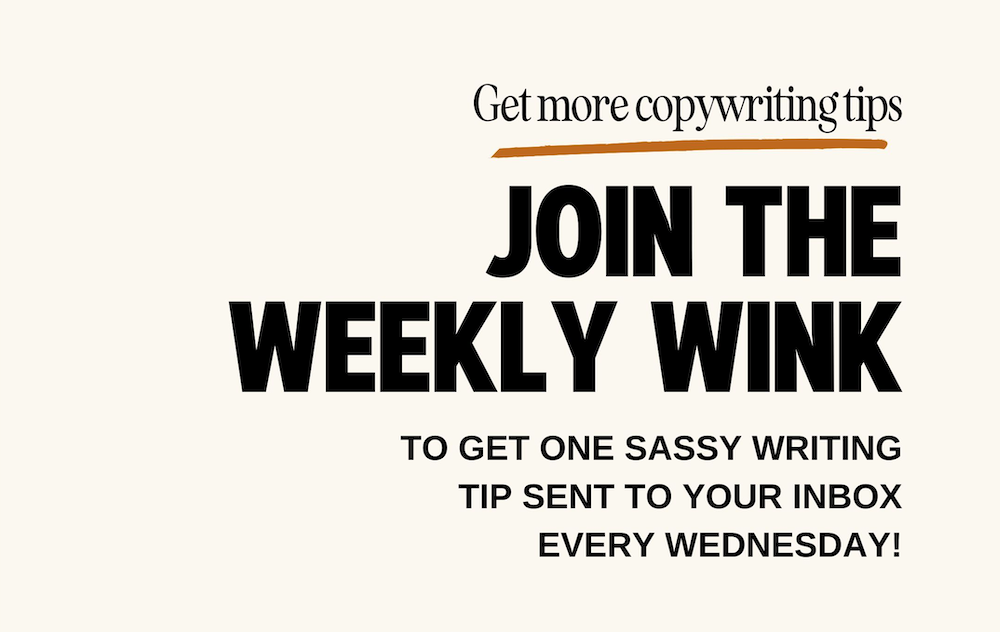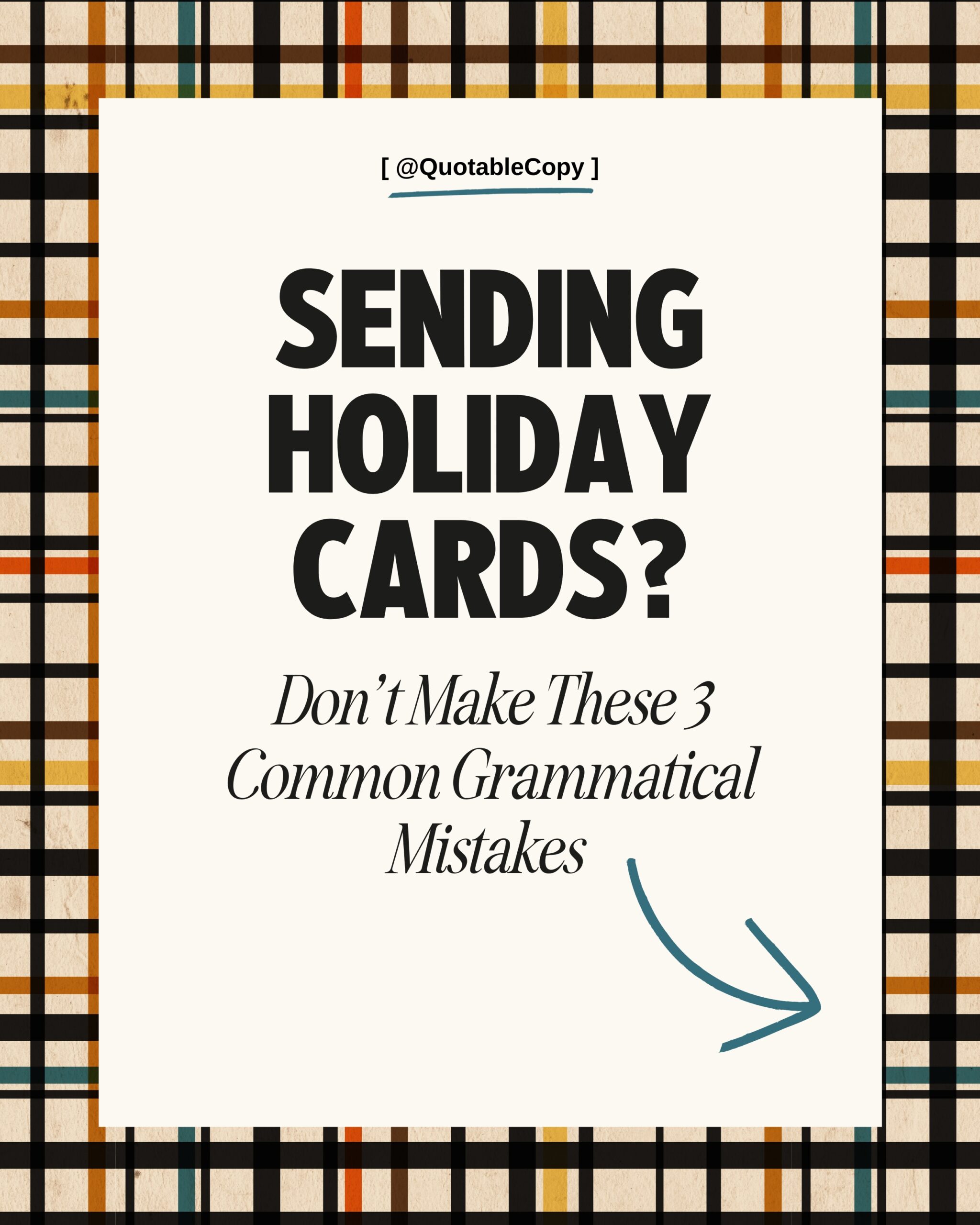OUr signature service
Allow us to craft your website copy, long-form sales page, launch email sequence, ad copy, or other need-it-now copy needs.
Free download
How strong is your brand voice? If you aren't sure, this guide is for you. Download our gorgeous, 20-page magazine to learn our secrets to writing with style.
VIP Day
Brand Voice Magazine
[ Tell Me More ]
[ Download Now ]
New!
How's your website really doing? Let's find out. Get the actionable tips you need to optimize your site (read: convert more clients).
Website Audit
[ I'm Intrigued ]
BY Sarah Klongerbo
Hello! Thanks for making this page a pitstop on your web-browsing journey. Please, stay awhile! We've got plenty of reading material to help you pass the time—and enhance your brand & copywriting while you're at it.
Follow @quotablecopy
[ Meet Our Founder & Editor In Chief ]
Grab the Brand Voice Magazine!
[ Download The Copy Edit ]
keep learning ABOUT:
tools & systems
STRATEGY & SALES
business & branding
copywriting & editing
productivity & life
Get Weekly Copywriting Tips!
[ Join The Weekly Wink ]
Cold Email Tips for Creatives: How to Get a (Positive!) Response
Do cold outreach emails work for creative businesses? Maybe — if your messaging is on point.
Learn how to write a cold email that doesn’t just get a response; it get the positive response you’re looking for.
Here’s what you’ll learn in this post:
- Why creatives should send cold emails
- How we successfully used cold outreach as a copywriting studio
- 8 cold outreach tips to get your emails opened, read, and replied to
- Other cold outreach ideas (that aren’t just email)

Should Creative Businesses Send Cold Emails?
As creatives, we cringe at the thought of sales-y sales tactics. So the concept of cold email outreach — AKA emailing someone you don’t know — isn’t exactly appealing.
But cold outreach CAN be valuable for creative businesses, especially those in a service-based industry like design, coaching, marketing, event planning, or, yes, copywriting.
And, as we’ll show you, cold outreach can even be creative, too.
7 Reasons to Try Cold Outreach
You can’t expect clients to magically appear in your inbox all the time (or even some of the time).
If inquiries are low, cold outreach can help you generate some business — or at least some connection.
Here are a few reasons you may want to consider sending a cold email as a creative entrepreneur:
- You want to expand your network.
- Maybe you want to meet other vendors in the wedding world, or you want to connect with fellow photographers. Cold outreach can help you build relationships in your industry.
- You want to drum up business.
- If inquiries are slow, why not send an inquiry of your own? A cold email to an ideal client could be the ticket to boosting sales — or, if you’re open to pro-bono work, building up your portfolio.
- If you’re B2B, you may try a strategy called account-based marketing, which targets specific, high-value businesses instead of casting a broad net.
- You want to meet your hero.
- Are you a big fan of someone’s work? Let them know! One beautiful thing about the creative industry is that (almost) everyone is so nice. You might not get a response, let alone the one you want — but it can’t hurt to try. (Just be sure to offer something of value in return, if you can.)
- You want to share an opportunity.
- Perhaps you’re hosting an event at which you’d love to have a potential speaker or attendee. Use cold outreach to invite people to participate in speaking gigs, networking opportunities, exciting projects, or opportunities for professional growth.
- You want to share your story with the press.
- Cold outreach is a good (and often necessary) way to promote your business via PR. Submit a press release, or pitch an episode idea to a relevant podcast. (Be sure it’s a specific, engaging topic, not just a general, “Here I am; buy from me.”)
- You want to sharpen your sales skills.
- Cold emailing can be a great way to test a new service, messaging strategy, or call to action. If someone books a call, you get to test out your conversational sales skills, too.
- You want to take advantage of a slow season.
- Summers and holidays can be slow booking periods for creative service providers. Don’t just sit on your hands — reach out to the people you now have time for!
Our Cold Outreach Success Story
So, cold outreach can be a good idea for creatives. But does it work?
It definitely can. Our copywriting studio is proof.
The other week, we reached out to someone we’d never met. We customized the message, kept it brief, and included a link to a page on our site with more info on the topic at hand.
She could have ghosted or given a polite, “Thanks, but no thanks.”
Instead, this is what she said:
“I absolutely LOVE your website… it just stood out so much to me. It’s not often I’ll get an outreach email and the site looks that epic. Then of course there are your words. I love your whole vibe, the wording (obvs) and how simple you made the process sound. I would actually love to book a call with you as I have something cool I’d love to share with you, if you’re interested. I’d really love to help and share your services.”
Wow. 🧡 Not your typical reply, eh?
We’d love to show you how YOUR cold email can get a glowing reply, too.
8 Tips to Get Your Cold Emails Opened, Read, and Replied To
Cold outreach emails get a bad rap — for good reason — but that doesn’t mean you can’t send them.
If you ever want to reach out to someone you don’t know on behalf of your business, here are a few tips to get a positive response.
1. Start with a Goal
This should be obvious, but you should never reach out to someone without a reason.
Whether you’re contacting one person or 100, keep a clear goal in mind when writing each email. Stay in that mindset until you hit “send.”
For larger outreach campaigns, start a spreadsheet to track each contact. Columns could include:
- Contact name
- Company name
- Website
- Email address
- LinkedIn profile
- Other mode(s) of contact
- Project status
- Notes
When you see each contact at a glance, your campaign becomes a numbers game. If you have 100 prospects, and even a fraction become paying clients, that’s success!
Keep track of your conversion rate, and keep attempting to beat it.
2. Reach Out to the Right Person
Who’s your target audience? Approach only people whose audience and approach align with yours.
Make sure the person you’re contacting might actually care about what you have to say. If they wouldn’t, don’t bother. Otherwise, you’re part of the reason cold outreach gets a bad rap!
Also, check that you have the right person at the business. Usually that’s the owner or marketing manager, not an assistant, who might let your email slip through the cracks.
3. Find Common Ground
Take the cold out of cold outreach. Make your message warm!
Do your due diligence to learn about the recipient, so you can personalize your email as much as possible.
We’re talking more than a standard, “Hello, [NAME].” Find something in common — bonus points if it’s quirky.
Flattery can be, well, flattering — but don’t patronize the person. Only compliment them if you have something specific and genuine to say (like, “I loved your take on planning corporate events — you said what we’re all thinking!”).
Make yourself even more relatable by including GIFs, a memorable email signature, or other elements that show your personality. Design can be a great way to find common ground and stand out in the inbox.
4. Entice Them to Open
If your recipient doesn’t open your email, nothing you write inside it matters. So make sure your email is enticing enough to open!
Test different from names (like “Sarah Klongerbo” vs. “Sarah at Quotable Copy”).
Even more important, optimize your subject line. It should be intriguing, concise, and non-spammy. The more personalized, the better!
5. Pique Their Curiosity
The goal isn’t to “convert” your recipient. It’s to get them interested enough, they want to learn more.
When writing to someone you don’t know, always ask yourself, “What’s in it for them?” Some examples of outcomes you could promise include:
- A fun creative challenge
- Exposure to new industries, solutions, or tech
- Valuable compensation
- A partnership opportunity
- The chance to make a meaningful impact
Keep the recipient’s #1 problem in mind, and share how you can help them overcome it. If you can share one specific example of how your value prop has worked, even better.
Need some help actually structuring your cold email? Here are 15 templates to try.
6. Offer One Clear Next Step
Don’t try to cram several CTAs into one cold email. Focus on ONE thing you want the person to do.
That request could be:
- Book a meeting: “Are you available for a 15-minute chat next Friday?”
- Offer more information: “Click here to learn more about this offer”
- Pro tip: Include a link, not an attachment, which can trigger spam filters. (Some links do, too, so just watch your deliverability rate.)
- Start a conversation: “Would you be open to discussing this further?”
We recommend having this request be the very final line of your email, so your reader feels compelled to reply.
Feeling tempted to include more than one CTA? Consider using your email signature to link to other resources your recipient could find worthwhile.
7. Keep It Quick
People scan emails, especially if they don’t know who it’s from. Be brief!
Write as though you’re emailing a friend: be conversational, and don’t feel the need to tell your whole life story. You can always share more later.
You may even consider replacing text with a Loom video, giving your email a friendly face to the friendly name. Keep it to one or two minutes, max.
8. Follow Up—No Matter What
Often, creatives complain their cold email didn’t work — when they sent only one. Well, no wonder!
Most initial emails go unanswered (or even unread)… and that’s okay. Don’t take it personally. But don’t give up, either. Because follow-ups can increase your response rate by up to 40%.
Follow up a few business days after your first outreach email with a gentle nudge. If the person still doesn’t reply, try again a week later.
Ideally, your follow-up emails don’t just say, “Just following up!” You should try to provide some additional value if you can — maybe a relevant resource or mutual connection.
Don’t follow up forever, though. Stop after two or three attempts. You don’t want to come across too desperate, especially if you’re concerned about your brand reputation with this recipient.
If you never hear back, simply note it and move on. Their lack of response has no bearing on your worth — but it can provide some insight you can use to adjust your sales and marketing going forward.
If you DO hear back… congratulations! You’ve just proved that cold outreach can work for creatives. 🎉
Creative Outreach Ideas That Aren’t Just Email
We’ve been talking about cold outreach mostly as plain-text email, but there are other ways to approach a prospect. You could:
- Fill out their contact form
- Send a custom Loom video
- DM them on Instagram
- Send a LinkedIn message
- Invite them to an exclusive training
You’re a creative… so get creative!
Want More Creative Marketing Tips?
We’re all about helping you get better engagement from your audience — whether it’s icy cold or cozy warm.
Join our newsletter, The Weekly Wink, to get a new strategic piece of marketing advice every Wednesday!

Keep up the good reading
[ See All Articles ]
©2023 – 2025 Quotable Copy™








